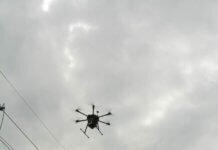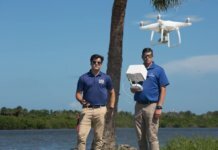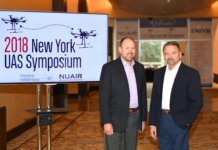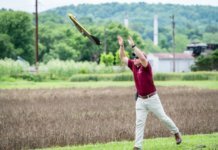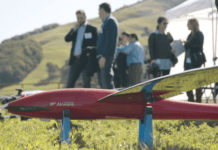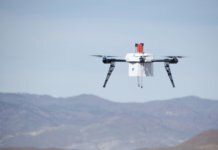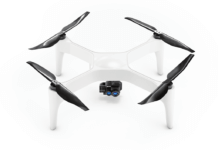Drone operations taking place beyond the visual line of sight (BVLOS), though necessary in a number of commercial industries seeking to use unmanned aircraft systems (UAS) technology to its full potential, are certainly not taking place across the board – simply because the regulatory framework is not yet in place. However, a number of entities across the country, including federally designated test sites, are feverishly working toward a future in which BVLOS is, indeed, a reality, as emphasized today during a panel at XPONENTIAL 2017 in Dallas.
Held this afternoon at the Association for Unmanned Vehicle System International’s (AUVSI) annual event, the session, entitled “The Future of BVLOS Operations,” brought together some of the Federal Aviation Administration (FAA) test site operators; Virginia’s secretary of technology, Karen Jackson; Gryphon Sensors, which provides the technology to move BVLOS operations forward; and BNSF Railway, a pioneer in the deployment of UAS for rail inspections.
When moderator Brett Davis, vice president of communications and publications for AUVSI, asked the panelists what they’ve learned the most during their time advancing BVLOS drone operations, Todd Graetz, part of BNSF’s UAS program, answered, “The flying is the easy part; that’s the surprising thing.”
“There is so much more to the large-scale use of unmanned systems than a flying object,” he remarked. To elaborate, Graetz noted that it’s “all the support systems” that are of the utmost importance: e.g., control systems, sensors, data analytics – “everything that’s required to operate [drones] in scale.”
Likewise, Matt Scassero, director of the University of Maryland’s UAS test site, which is part of the FAA test site based at Virginia Tech, said that “flying is the easy part,” but the bigger part of the picture is making the case for safety through testing and risk-based analysis, he explained.
“That’s why the test sites were put in place,” noted Jackson, who said the sites are there to conduct the experiments in order to further advance drone operations countrywide.
“If we’re going to do this safely … then the test sites need to be an integral part of that conversation moving forward,” she said.
Take the site at North Dakota – an ever-evolving state for unmanned systems – for example. At the end of last year, it inked the first UAS test site approval for BVLOS drone operations and, in turn, is “working on something that can [eventually] be used across the country,” said Nicholas Flom, director of the the state’s Northern Plains test site.
Craig Marcinkowski, director of strategy and business development at North Syracuse, N.Y.-based Gryphon Sensors, which provides sense-and-avoid technology for UAS, noted that North Dakota and BNSF Railway have “really blazed the trail” when it comes to BVLOS operations. BNSF Railway, which has been a part of the FAA’s Pathfinder program to advance UAS integration, also scored a waiver last year to take drones beyond line of sight.
Importantly, Graetz says BNSF has taken a “very collaborative” approach to its work.
“We share a great deal of our findings with other railroads,” he said, noting that the company is “very inclusive” when it comes to sharing data and tips with similar companies, who will “likely adopt similar things” going forward.
Marcinkowski also brought up the major investments New York is making in unmanned systems and how important it is to “get everyone together and leverage the resources available.” In New York’s case, the state is home to another FAA test site, as well as Project U-SAFE, which aims to further advance UAS integration and testing. The initiative has received major funding from the state, including last year’s announced $50 million investment to develop a UAS traffic management corridor.
So, you wanna fly BVLOS?
According to Flom, details were key in getting North Dakota’s green light: The team presented a “concept of operations” and an “operational risk assessment” to the FAA and, in turn, proved to the agency that it could make the safety case. Starting from the “beginning of flight to the end of flight,” you must break it down completely if you’re looking to convince the FAA you’re ready to take drones beyond your line of sight, he said.
To break it down even further, he advised that entities offer to the FAA as follows: First, what will your flight look like, and who will be involved? Next, go “line by line” and look at who’s doing what and what role everyone will have, such as acting as a visual observer or training the operator. Then, “go through the entire flight” and figure out your emergency protocols, your communication tactics, and what kind of equipment you’re using exactly.
Scassero noted, “You have to think about it the way the FAA thinks about it.”
“You have to build the safety case for whatever you’re doing,” he said. “Having that approach from the beginning will make your life easier.”
He also warned that you should probably stay away from one little word: “just.” No, you’re not “just” going to take drones beyond your line of sight; there’s way too much involved in the process.
“It’s never ‘just,’” he quipped.
The long run
When Davis asked the group where they envision BVLOS drone operations in five years, each panelist was pretty optimistic about the direction things are likely headed.
“We’ll have a network to enable it on a routine basis,” Flom affirmed, followed by Graetz, who said there will be in place a “body of data and a series of safety cases.”
“We’re hugely optimistic that we will have that creative, collaborative environment,” added Scassero.
Marcincowski also expects there to be a “fully autonomous flight environment” in which drones are not only operating beyond line of sight but also over people (another important hurdle to cross in the journey toward full UAS integration, of course).
For Jackson, it would be a “monumental accomplishment” to have this type of operation across Virginia’s government operations in particular, she said.
“It’ll be business as usual for some use cases,” noted Scassero, who did, however, bring up how much a bad incident could “set us all back” in terms of regulation and public perception of the technology.
However, pointing back to the importance of details and efficiency in making your case to fly drones beyond your line of sight, he advised that we must “approach it properly with the right mindset.”
On that end, Jackson brought up earlier in the panel the concept of “crawl, walk, run” on the regulatory side: Technology is “moving at the speed of a bullet,” she said, but the regulators are approving different types of drone operations in various (sometimes slow) stages.
“How do you fix that juxtaposition?” she asked. “How do you put a man on the moon in a regulatory environment with ‘crawl, walk, run?’”
“We’re at such a transformative period with technology … we’re trying to find that balancing act,” said Jackson.
“The fire is there. I think everyone in this room has it. But how do you balance that vision with the need to be safe?”



